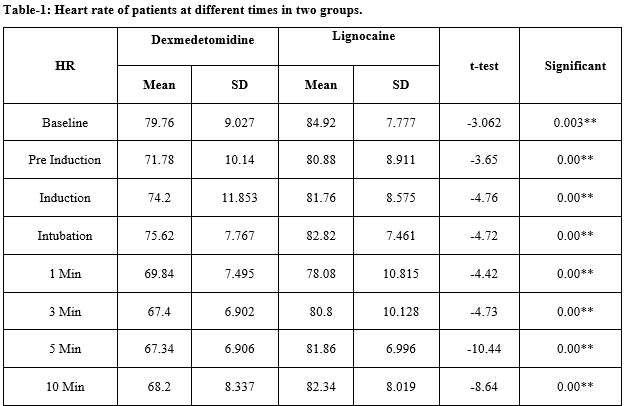Comparison of efficacy of Lignocaine 1.5 mg/kg & Dexmedetomidine 1 μg/kg in attenuating the hemodynamic pressure response to laryngoscopy & intubation
Abstract
Background: Dexmedetomidine attenuates the hemodynamic stress response tolaryngoscopy and intubation more effectively compared with Lignocaine without any deleterious effects. To study the efficacy of Lignocaine 1.5 mg/kg & Dexmedetomidine 1 μg/kg in attenuating the hemodynamic pressure response to laryngoscopy & intubation.
Material and Methods: A total of 100 American Society of Anesthesiologists (ASA) physical status I and II patients aged between 18 and 50 years undergoing elective surgery were enrolled in the study. Patients posted for elective surgery were randomly selected and divided into two groups. Group L = 50 Patients had given 1.5mg/kg Lignocaine; Group D = 50 Patients had given 1µg / kg Dexmedetomidin.
Results: In Dexmedetomidine group, HR, SBP, DBP and MAP showed significant decrease throughout the study period, as compared to Lignocaine group. The statistical analysis shows that, in Dexmedetomidine group, HR, SBP, DBP and MAP showed significant decrease throughout the study period, as compared to Lignocaine group.
Conclusion: Newer agents like Dexmedetomidine, a centrally acting alpha-2 agonist suppresses reflex sympathetic stimulation caused by laryngoscopy & intubation more effectively than Lignocaine. Thus, it is concluded that Dexmeditoedine is a better drug compared to Lignocaine in attenuating pressure response to laryngoscopy & intubation.
Downloads
References
Shribman AJ, Smith G, Achola KJ. Cardiovascular and catecholamine responses to laryngoscopy with and without tracheal intubation. Br J Anaesth. 1987;59(3): 295-299. doi: https://doi.org/10.1093/bja/59.3.295
Kovac AL. Controlling the hemodynamic response to laryngoscopy and endotracheal intubation. J Clin Anesth. 1996;8(1):63-79. doi: https://doi.org/10.1016/0952-8180(95)00147-6
Mikawa K, Ikegaki J, Maekawa N, Goto R, Kaetsu H, Obara H. The effect of diltiazem on the cardiovascular response to tracheal intubation. Anaesthes. 1990;45(4):289-293. doi: https://doi.org/10.1111/j.1365-2044.1990.tb14734.x
Mikawa K, Obara H, Kusunoki M. Effect of nicardipine on the cardiovascular response to tracheal intubation. Br J Anaesth. 1990;64(2):240-242. doi: https://doi.org/10.1093/bja/64.2.240
Kumar S, Mishra MN, Mishra LS, Bathla S. Comparative study of the efficacy of iv esmolol, diltiazem and magnesium sulphate in attenuating haemodynamic response to laryngoscopy and tracheal intubation. Indian J Anaesth. 2003;47(1):41-44.
Kautto UM. Attenuation of the circulatory response to laryngoscopy and intubation by fentanyl. Acta Anaesthesiol Scand. 1982;26(3):217-221. doi :https://doi.org/10.1111/j.1399-6576.1982.tb01757.x
Fassoulaki A, Kaniaris P. Intranasal administration of nitroglycerine attenuates the pressor response to laryngoscopy and intubation of the trachea. Br J Anaesth. 1983;55(1):49-52. doi: https://doi.org/10.1093/bja/55.1.49
Stoelting RK. Blood pressure and heart rate changes during short-duration laryngoscopy for tracheal intubation: influence of viscous or intravenous lidocaine. Anesth Analg. 1978; 57 (2):197-199. doi: https://doi.org/10.1213/00000539-197803000-00009
Abou-Madi MN, Keszler H, Yacoub JM. Cardiovascular reactions to laryngoscopy and tracheal intubation following small and large intravenous doses of lidocaine. Can Anaesth Soc J. 1977;24(1):12-19. doi: https://doi.org/10.1007/BF03006808
Laurito CE, Baughman VL, Becker GL, Polek WV, Riegler FX, VadeBoncouer TR. Effects of aerosolized and/ or intravenous lidocaine on hemodynamic responses to laryngoscopy and intubation in outpatients. Anesth Analg. 1988;67(4):389-392.
Wilson IG, Meiklejohn BH, Smith G. Intravenous lignocaine and sympathoadrenal responses to laryngoscopy and intubation. The effect of varying time of injection. Anaesthes. 1991; 46(3):177-180. doi: https://doi.org/10.1111/j.1365-2044.1991.tb09403.x
Kindler CH, Schumacher PG, Schneider MC, Urwyler A. Effects of intravenous lidocaine and/or esmolol on hemodynamic responses to laryngoscopy and intubation: a double-blind, controlled clinical trial. J Clin Anesth. 1996;8(6):491-496. doi: https://doi.org/10.1016/0952-8180(96)00109-2
Miller CD, Warren SJ. IV lignocaine fails to attenuate the cardiovascular response to laryngoscopy and tracheal intubation. Br J Anaesth. 1990;65(2):216-219. doi: https://doi.org/10.1093/bja/65.2.216
Yildiz M, Tavlan A, Tuncer S, Reisli R, Yosunkaya A, Otelcioglu S. Effect of dexmedetomidine on haemodynamic responses to laryngoscopy and intubation: perioperative haemodynamics and anaesthetic requirements. Drugs R D. 2006;7(1):43-52. doi: https://doi.org/10.2165/00126839-200607010-00004
Scheinin B, Lindgren L, Randell T, Scheinin H, Scheinin M. Dexmedetomidine attenuates sympathoadrenal responses to tracheal intubation and reduces the need for thiopentone and peroperative fentanyl. Br J Anaesth. 1992;68(2):126-131. doi: https://doi.org/10.1093/bja/68.2.126
Keniya VM, Ladi S, Naphade R. Dexmedetomidine attenuates sympathoadrenal response to tracheal intubation and reduces perioperative anaesthetic requirement. Indian J Anaesth. 2011; 55(4):352-357. doi: https://dx.doi.org/10.4103%2F0019-5049.84846.
Menda F, Köner O, Sayin M, Türe H, Imer P, Aykaç B. Dexmedetomidine as an adjunct to anesthetic induction to attenuate hemodynamic response to endotracheal intubation in patients undergoing fast-track CABG. Ann Card Anaesth. 2010;13(1):16-21. doi: https://doi.org/10.4103/0971-9784.58829.
El-Shmaa NS, El-Baradey GF. The efficacy of labetalol vs dexmedetomidine for attenuation of hemodynamic stress response to laryngoscopy and endotracheal intubation. J Clin Anesth. 2016;31:267-273. doi: https://doi.org/10.1016/j.jclinane.2016.01.037. Epub 2016 Apr 18.
Feng CK, Chan KH, Liu KN, Or CH, Lee TY. A comparison of lidocaine, fentanyl, and esmolol for attenuation of cardiovascular response to laryngoscopy and tracheal intubation. Acta Anaesthesiol Sin. 1996;34(2):61-67.
Lee JH, Kim H, Kim HT, Kim MH, Cho K, Lim SH, et al. Comparison of dexmedetomidine and remifentanil for attenuation of hemodynamic responses to laryngoscopy and tracheal intubation. Korean J Anesthesiol. 2012;63(2):124-129. doi: https://dx.doi.org/10.4097%2Fkjae.2012.63.2.124. Epub 2012 Aug 14.
Reddy SV, Balaji D, Ahmed SN. Dexmedetomidine versus esmolol to attenuate the hemodynamic response to laryngoscopy and tracheal intubation: A randomized double-blind clinical study. Int J Appl Basic Med Res. 2014; 4(2):95-100. doi: https://dx.doi.org/10.4103%2F2229-516X.136788.
Hanci V, Erdoğan G, Okyay RD, Yurtlu BS, Ayoğlu H, Baydilek Y, et al. Effects of fentanyl-lidocaine-propofol and dexmedetomidine-lidocaine-propofol on tracheal intubation without use of muscle relaxants. Kaohsiung J Med Sci. 2010;26(5):244-250. doi: https://doi.org/10.1016/S1607-551X(10)70035-8.
Gulabani M, Gurha P, Dass P, Kulshreshtha N. Comparative analysis of efficacy of lignocaine 1.5 mg/kg and two different doses of dexmedetomidine (0.5 μg/kg and 1 μg/kg) in attenuating the hemodynamic pressure response to laryngoscopy and intubation. Anesth Essays Res. 2015;9(1):5-14. doi: https://dx.doi.org/10.4103%2F0259-1162.150167.
Prasad SR, Matam UM, Ojili GP. Comparison of intravenous lignocaine and intravenous dexmedetomidine for attenuation of hemodynamic stress response to laryngoscopy and endotracheal intubation. Journal of Dr. NTR University of Health Sciences. 2015; 4(2): 86-90. doi: https://doi.org/10.4103/2277-8632.158579



 OAI - Open Archives Initiative
OAI - Open Archives Initiative


